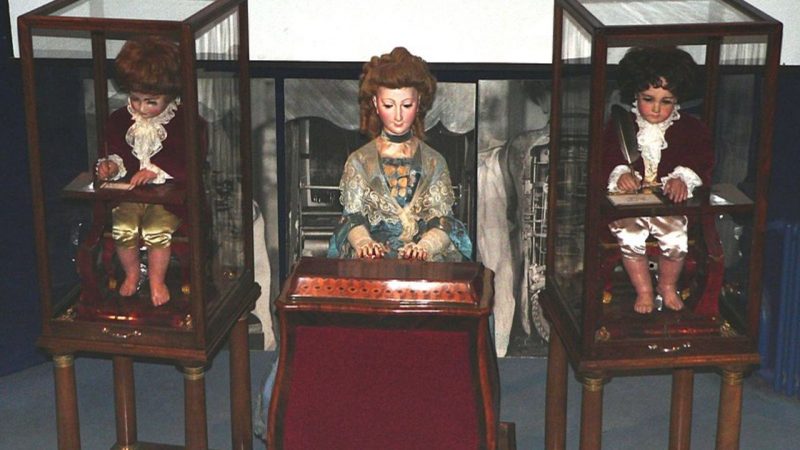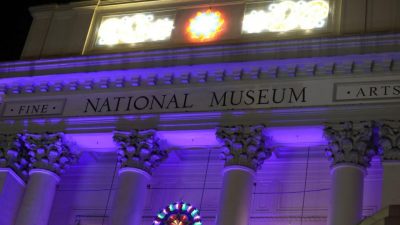FROM Leonardo Da Vinci’s android to a French-made artificial duck, learn more about seven early mechanical wonders of the world.
1. The Mechanical Monk
The 16th-century “mechanical monk” may have been the result of King Phillip II of Spain keeping up his end of a holy bargain. According to legend, Phillip II’s son and heir suffered a head injury, and the King vowed to the heavens that he would deliver a miracle if the boy were spared. When the Prince recovered, Phillip II commissioned a clockmaker and inventor named Juanelo Turriano to build a lifelike recreation of beloved Franciscan friar Diego de Alcalá (later Saint Diego).
Completed sometime in the 1560s, Turriano’s 15-inch-tall automaton is powered by a wound spring and uses an assortment of iron cams and levers to move on three small wheels concealed beneath its monk’s robe. Artificial feet step up and down to imitate walking, and the friar’s eyes, lips, and head all move in lifelike gestures. Working together, these elements give the impression of a monk deep in prayer. The robot can walk in a square pattern mouthing devotionals, nodding its head and occasionally beating its chest with its right arm and kissing a rosary and cross with its left. The 450-year-old device is still operational today and is held at the Smithsonian in Washington, D.C.
2. Al-Jazari’s Floating Orchestra
In the 12th and 13th centuries, the Arabic polymath Al-Jazari designed and built some of the Islamic Golden Age’s most astounding mechanical creations. He invented a mechanized wine-servant, water-powered clocks and even a hand-washing machine that automatically offered soap and towels to its user.
According to his “Book of Knowledge of Ingenious Mechanical Devices,” published in 1206, he also designed a water-powered automaton orchestra that could float on a lake and provide music during parties. The contraption included a four-piece band—a harpist, a flutist, and two drummers—accompanied by a crew of mechanical oarsmen who “rowed” the musicians around the lake. The waterborne orchestra operated via a rotating drum with pegs that triggered levers to produce different sounds, and other elements allowed the musicians and crewmen to make realistic body movements. Since the pegs on the rotating drum system could be replaced to create different songs, some have argued that Al-Jazari’s robot band was one of history’s first programmable computers.
3. Archytas’ Dove
Archytas of Tarentum was a renowned mathematician and politician, but according to some ancient sources, he may also be the grandfather of robotics. Sometime around 350 B.C., Archytas is said to have designed and built an air or steam-powered wooden dove that was capable of flapping its wings and flying through the air. No schematics or prototypes of the bird have survived to today, so modern scholars can only guess as to how it functioned.
Most assume that the free-flying dove described by the ancients was actually a hollow decoy filled with compressed air and connected to a pulley system. When the air was released, it may have caused the bird’s wings to flap and triggered a counterweight, which lifted the automaton from one perch to another and gave the impression of flight. While not as impressive as the ancient accounts—some of which claimed the bird could fly as far as 200 meters—such a device would still represent one of history’s earliest automatons.
4. The Silver Swan
The still-functional “Silver Swan” is an avian automaton originally constructed by showman James Cox and watchmaker John Joseph Merlin in 1773. Using a trio of clockwork motors, the piece recreates the scene of a preening swan floating in a babbling brook. Levers and springs allow the bird to bend its neck and open its bill with startling realism, and an assortment of camshafts and glass rods create the illusion of a moving body of water with swimming fish—one of which the swan appears to catch and eat. The machine also includes its own soundtrack provided by an internal music box.
Before being purchased by Durham, England’s Bowes Museum in 1872, the Silver Swan was exhibited in James Cox’s Mechanical Museum in London and at the 1867 Paris International Exhibition. Novelist Mark Twain saw the swan during a tour of France, and later wrote that the automaton fowl had “a living grace about his movement and a living intelligence in his eyes.”
5. Jaquet-Droz’s Three Automatons
Swiss inventor Pierre Jaquet-Droz originally made his name as a designer of luxury watches, but he is now remembered as the creator of three of the 18th century’s most extraordinary automatons. First built in 1768, “The Writer” was a two-foot-tall doll designed to look like a boy sitting at a desk. Using a series of coded disks set on a spindle and thousands of moving parts, the robot could dip a goosefeather quill in an inkwell and write up to 40 pre-programmed characters on a sheet of paper.
Along with his son, Henri-Louis, and an associate named Jean-Frédéric Leschot, Jaquet-Droz later developed two more early humanoid robots that worked on the same principle. “The Draughtsman” used a pen to draw four pictures—including a portrait of King Louis XV—while “The Musician” played five different songs on a fully functional organ. Each of the robots’ eyes would move to follow their actions, and “The Musician” was also designed to heave her chest as she “breathed” and took a bow in between tunes. The Jaquet-Droz automatons were exhibited to astonished crowds in Europe’s royal courts in the late 18th century and were later turned over to a museum in Switzerland. Amazingly, all three remain in perfect working order to this day.
6. Vaucanson’s Digesting Duck
In the 1730s, French inventor Jacques de Vaucanson wowed audiences with a series of intricate and eerily lifelike automatons. He created a mechanical flute player that used a pair of artificial “lungs” to perform a repertoire of 12 songs and later made a pipe-and-drum-wielding robot capable of playing faster than any human.
Vaucanson’s masterpiece came in 1739, when he unveiled a “Digesting Duck” that could flap its wings, splash in a pool of water, and—bizarrely—eat grain from audience members’ hands and defecate pre-loaded pellets onto a silver platter. The gilded copper automaton was powered by falling weights that turned into a sophisticated collection of cams and levers to replicate movement. Flexible rubber tubing—some of the first of its kind—served as the robot fowl’s entrails and gave the impression that it could actually swallow and digest its food.
Strange though it may seem, the dung-depositing duck enchanted 18th-century audiences, and it was exhibited in several royal courts in Europe. Vaucanson even won gushing praise from the likes of Voltaire, who compared him to Prometheus and wrote, “Without…the duck of Vaucanson, you will have nothing to remind you of the glory of France.”
7. Da Vinci’s Knight
Leonardo Da Vinci wrote extensively about automatons, and his personal notebooks are littered with ideas for mechanical creations ranging from a hydraulic water clock to a robotic lion. Perhaps most extraordinary of all is his plan for an artificial man in the form of an armored Germanic knight.
According to Da Vinci’s sketches of the key components, the knight was to be powered by an external mechanical crank and use cables and pulleys to sit, stand, turn its head, cross its arms, and even lift up its metal visor. While no complete drawings of the automaton exist today, evidence suggests that Da Vinci may have actually built a prototype in 1495 while working under the patronage of the Duke of Milan. In 2002, NASA roboticist Mark Rosheim used Da Vinci’s scattered notes and sketches to see if he could create his own version of the 15th-century automaton. The Rosheim knight proved fully functional, suggesting that Da Vinci may very well have been a robotics pioneer.
Source: History Channel/Evan Andrews
(Filed by Jr Amigo/ai/mnm)







